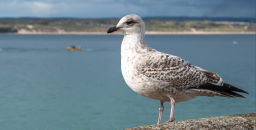Rockcliffe Marsh in Cumbria lies at the head of the Solway Estuary. The mixed herring and lesser black-backed gull colony here has been a feature of the saltmarsh for nearly a century. From a single pair of lesser black-backs in 1925 the colony grew to 250 pairs by 1933 and 600 in 1967, by which point 12 pairs of herring gulls were also nesting. Since that time the colony has averaged around 1000 pairs for much of its history, though the colony averaged closer to 10,000 pairs in the 1990’s. In recent years the colony has reduced to a few hundred pairs. The colony bias towards lesser black-back gulls has been maintained throughout its history with a maximum of about 2000 pairs of herring gull during the peak years of the 1990’s. Productivity has varied widely over the years with food supply issues, fox predation and stock disturbance have all been implicated in colony failure at times. During the peak years of the 1990's birds were thought to be making use of local landfill sites to supplement natural food sources. The colony has always been susceptible to storm tides during the breeding season, and these are predicted to become more frequent in the future as a consequence of climate change.
Ringing of gull chicks using standard BTO metal rings has been carried out when productivity has allowed since the mid 1990’s and in 2020 it was added to the colour ringing project.
Rockcliffe Marshes

